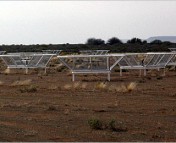Title: LOFAR: opening a new window on low frequency radio astronomy
Authors: R. Morganti for the LOFAR collaboration
First Author’s Affiliation: ASTRON and the Kapteyn Astronomical Institute, The Netherlands
Tune down that radio dial
The radio portion of the electromagnetic spectrum has only been used in astronomical research for the last half-century, but has enabled many great discoveries and contributed significantly to our understanding of the Universe. Measuring 21 cm radiation from neutral Hydrogen at 1420 MHz has allowed us to map the gas content and velocity structure of galaxies in unprecedented detail; the discovery of pulsars gives us our most direct probe of exotic neutron stars; and, studying synchrotron emission associated with high-energy phenomena has led to insight into the extreme physical processes that can occur in the Universe, to name a few examples. The radio regime stretches across an incredibly huge portion of the spectrum, from (sub)millimeter wavelengths (up to 1 THz) out to the low-frequency cutoff (due to scattering from the Earth’s ionosphere) at hundred-meter wavelengths (a few MHz) – that’s nearly SIX decades in energy (or equivalently, wavelength or frequency), larger than the range covered by the entire ultraviolet, visible, and infrared regions combined! The most commonly used receivers at large radio telescopes and interferometers operate at frequencies above 500 MHz, leaving a large portion of the radio band virtually unexplored. But new facilities are changing this trend, and it is quite possible that the next major discovery in radio astronomy will come at low frequencies. Recent results from the ongoing commissioning of one the latest such facilities – LOFAR – were presented at the Asian-Pacific Regional IAU (International Astronomical Union) meeting, and also posted on astro-ph as the paper discussed in today’s astrobite.
Before you read any further, I suggest you have a look at Tanmoy’s excellent summary of radio astronomy here.
Specifications
LOFAR, the LOw Frequency ARray, is a radio telescope in the Netherlands consisting of multiple phased-array antennas that operates in the 10-240 MHz (1-20 m) range. As suggested by its acronym, LOFAR is an interferometer, but unlike other examples such as the VLA and ALMA (see this astrobite by Ian for more acronyms), it is not comprised of radio dishes, but instead dipole antennas. Dipoles are metal rods of a specific length that are oriented so that the charges within them respond to an incident electric field from a particular direction. In other words, they are functionally similar to television antennas – but tuned to frequencies appropriate for astronomical sources. Using dipoles is cost-effective, and also allows for an enormous field of view, as radiation from any direction except one parallel to the axis of the dipole will induce a response in the antenna. They are not used in higher frequency astronomy because the “collecting area” of a dipole shrinks with the wavelength of radiation and so radio dishes are much more efficient at short wavelengths, but they work perfectly at the low frequencies of LOFAR.
LOFAR’s thousands (!) of dipoles are organized into groups called “stations”: 24 stations comprise the main portion of the telescope and are located within 2 km of the center of the array, 9 others are more remote (within 100 km), and 8 are placed internationally (see Figure 1); more stations are planned to be added in the near future. LOFAR operates in two frequency ranges, and has separate antennas for each: the Low-Band Array (LBA) at 10-90 MHz, and the High-Band Array (HBA, whose antennas are shown close-up in the title image) at 110-240 MHz. Why the hole between 90-110 MHz? Check your FM dial! Radio-frequency interference (RFI) is a serious problem in radio astronomy, and in some cases (such as in the FM radio range) renders the sky unobservable. (One only hopes that the Universe’s deepest secrets are not uniquely revealed at 100 MHz!)
 Figure 1 – Map of location of LOFAR antennas (right), including the core array (“superterp”, inset right) and international stations (in red). The LBA and HBA antennas are shown at left.
Figure 1 – Map of location of LOFAR antennas (right), including the core array (“superterp”, inset right) and international stations (in red). The LBA and HBA antennas are shown at left.
The antennas can be configured in a multitude of ways, either combining or splitting data from different stations (and sometimes even within a single station) to observe targets large or small, bright or faint. LOFAR also achieves sub-milliJansky sensitivity – meaning that the level of noise is low enough that even very weak sources can be observed – and subarcsecond resolution – meaning that sources separated by angular distances less than an arcsecond (1/3600 of a degree) on the sky can be resolved. (For comparison, the full moon subtends 30 arcminutes, i.e. 1800 arcseconds!) LOFAR is extremely flexible, and can observe as a standard interferometer, by combining beams from several stations into a single coherent beam, or be triggered in real-time by transient detections.
This flexibility and power comes at a price, however; LOFAR generates a staggering 13 Terabits of raw data per second, far more than could possibly be transferred conventionally! Combining data at the station level allows this to be reduced to a “paltry” 150 Gigabits per second, which still requires dedicated fiber lines to keep up. Observations can easily generate 35 Terabytes of data each hour, making data storage a real concern as well. In addition, a highly accurate model of the sky and well-understood beam pattern are needed to calibrate the telescope and perform the deconvolution necessary to turn raw interferometric data into images. Needless to say, there is an entire team of software engineers – and a 28 Teraflop supercomputer – dedicated to addressing these computational challenges.
Science Goals
So, what can one do with thousands of dipoles? LOFAR was designed with four primary astrophysical goals: (1) studying the Epoch of Reionization through measurements of highly redshifted neutral Hydrogen; (2) exploring the formation and evolution of galaxies, clusters, and black holes; (3) transient sources, particularly in association with high-energy phenomena, and; (4) cosmic ray showers. Each of these will be briefly discussed below (much of this information came from an earlier paper posted by the LOFAR collaboration in 2007).
1. The Epoch of Reionization (EoR) is the period early in the history of the Universe when the first massive stars, galaxies, and/or quasars began producing enough ionizing radiation necessary to separate electrons from nuclei, which had recombined earlier due to the Universe’s rapid cooling and expansion (see this astrobite, and this one, and this one for more about the EoR). Before the EoR, most of the Hydrogen gas in the Universe (and specifically the gas between galaxies, or intergalactic medium [IGM]) was neutral, and thus emitted the ubiquitous 21 cm radiation; after the EoR, the majority was ionized, and thus would not be observed at 21 cm. Low-frequency studies probing the EoR are basically looking for the range in time over which the majority of the IGM went from being neutral to ionized by observing 21 cm radiation that has been very highly redshifted to meter wavelengths by the expansion of the Universe. Given that the background at low frequencies (from the galaxy, the solar system, and other bright sources in the radio sky) is orders of magnitude stronger than the extremely weak signal, this is a truly heroic observation, but in principle, LOFAR can use its high sensitivity and resolution to try to localize the EoR in space and time.
2. LOFAR’s very wide field-of-view makes it the perfect tool for large-scale sky surveys, and it will probe a frequency range that has been basically unexplored. It is expected that it will be able to identify more than a hundred radio galaxies at redshifts z > 6 , i.e. more distant than any yet known. These super-energetic sources are connected to both galaxy cluster and supermassive black hole formation, and observing them so early in the Universe could help clarify the nature of these connections. LOFAR will also observe diffuse radio emission in galaxy clusters out to z~2, probing their dynamics and the structure of intercluster magnetic fields, and measure the radio flux from distant star-forming galaxies, which can be combined with submillimeter observations to obtain accurate distances.
3. One of the most exciting things about LOFAR is the vast parameter space it opens up. Its gigantic field of view allows it to function as a very efficient synoptic telescope, and regular surveys will monitor a huge portion of the sky for transient sources, exploring variability on timescales from milliseconds to years. Some objects, such as pulsars, will be more fully characterized by studying their low-frequency spectra; for example, a recent result from early LOFAR has placed constraints the emission height within a pulsar’s magnetosphere. However, certain transients may also be indicative of entirely new and unknown astrophysical phenomena, and LOFAR is poised to discover objects potentially even stranger than black holes and pulsars (if one could dream of such a thing!)
4. Ultra high-energy cosmic rays (UHECRs) are also within reach of LOFAR. The telescope can be triggered by the detection of a cosmic ray shower from an external particle detector, or it can directly observe the radio emission produced in such a shower. This information can be combined with data from other facilities such as AUGER to better understand the formation and trajectories of UHECRs as well as the radiation mechanism involved in the shower process.

Figure 2 – Commissioning-phase images from LOFAR: nearby galaxy NGC 4631, four distant radio galaxies (center), and a galaxy cluster halo (right). Note the incredible resolution achieved!
A bright future
LOFAR is still in the commissioning phases, but the first science results are already starting to be produced – see Figure 2 for three examples: a normal galaxy, a quartet of radio galaxies, and a galaxy cluster halo. It is expected to be fully operational by the end of this decade, and is poised to revolutionize our understanding of the Universe through its unprecedented sensitivity and resolution, powerful survey capabilities, and access to previously unexplored parameter space. So while the frequency may be low, the promise of discovery for LOFAR is incredibly high.
For more detail regarding the recent LOFAR science results, see http://www.astron.nl/lofarscience2011/.





Trackbacks/Pingbacks